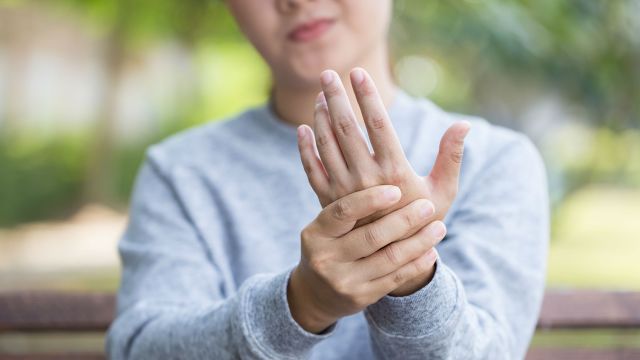Updated on April 7, 2025
You've noticed something lately. You can't seem to straighten out your ring finger, and your pinky is beginning to curl, too. It doesn't hurt necessarily, but you're having trouble putting gloves on. And fishing something out of your pocket is getting a little harder every day.
Does this sound familiar? If so, you might be developing a condition called Dupuytren's contracture. It happens when lumpy nodules form under the skin inside your hand. Eventually, they merge into cords that pull your outer fingers downward, reducing your hand's movement, as well as your ability to grasp items. Simply swinging a hammer or picking up a book may become difficult. And while Dupuytren's contracture isn't life-threatening, it can affect your day-to-day function.
Risk factors for Dupuytren’s contracture
Anyone can develop Dupuytren's contracture in one or both hands. Experts aren’t clear on what causes it. But genetics are thought to play the largest role, as the condition tends to be passed down through generations.
These factors also affect your risk:
- Sex: Men are about three or four times more likely to have Dupuytren's contracture than women, and the cases are typically more severe.
- Age: Chances increase as you get older, and most diagnoses occur after age 50. Children under 10 are very rarely affected.
- Heritage: Scandinavians and Northern Europeans are at a higher risk than Asian, Black, and Hispanic people. It's believed to affect between 4 and 6 percent of white people.
- Diabetes and epilepsy: Evidence is mixed, but these may be linked to a higher risk.
- Smoking and alcohol use disorder: Both are possibly associated with increased chances.
While some believe hand injuries triggers Dupuytren's contracture, there is debate among experts as to whether that's true. More research is needed for a definitive answer.
Diagnosis and treatment of Dupuytren’s contracture
Diagnosing Dupuytren's contracture is simple; you don't need blood tests or a drawn-out exam. Your healthcare provider will check your hand for nodes, and then ask you to flatten it on a table. If your fingers don't rest flat against the surface, there's a good chance you might have the condition.
Once you've been diagnosed, your healthcare provider will discuss what to do. A mild case of Dupuytren's contracture may not need to be addressed at all. Your provider may just keep an eye on it in case it gets worse.
More serious cases could require treatment to restore movement in your hand. These may involve:
- Needling/needle aponeurotomy: A healthcare provider punctures the cord(s) in your hand with a needle, breaking it up and restoring finger movement.
- Steroid injections: Steroids are injected into your hand to slow the condition's progress.
- Enzyme injections: An enzyme is injected into cords to weaken them. In the days following, a healthcare provider tries to straighten your fingers manually.
- Surgery: For severe cases that can't be treated otherwise, you may be able to have surgery to remove the affected tissues. It restores movement more completely, though it requires physical therapy afterward.
Despite this range of options, Dupuytren's contracture has no permanent cure, and there's a good chance it will come back. That's why it's important to watch for symptoms, and contact your healthcare provider if the signs reappear.






